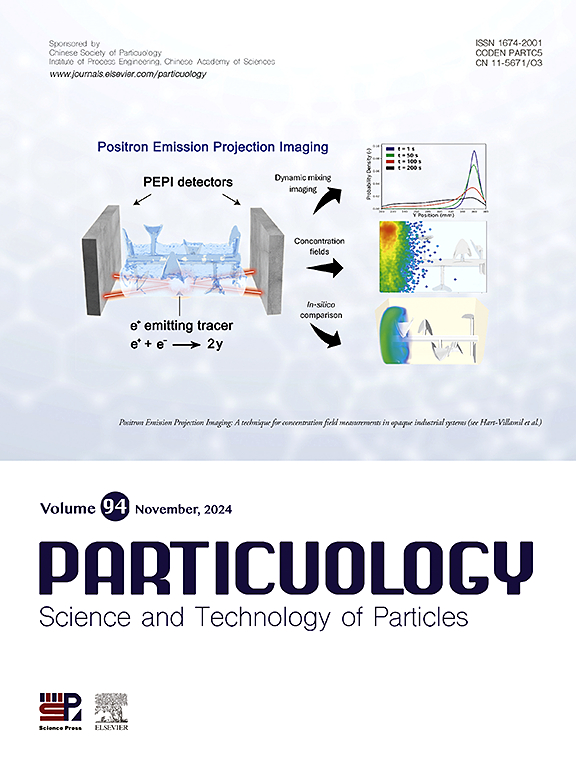不同均匀系数颗粒材料在循环剪切和约束压缩条件下的动态特性
IF 4.3
2区 材料科学
Q2 ENGINEERING, CHEMICAL
引用次数: 0
摘要
土在横波和纵波作用下的动力特性评价是岩土地震工程中的一个重要问题。本文采用三维离散元法研究了不同粒径分布的颗粒材料的刚度和阻尼特性的非线性应变依赖行为。基于循环三轴和循环约束压缩试验的模拟,分析了剪切模量和约束模量的非线性变化以及相关的阻尼比随应变的变化。对均匀系数(Cu)和循环加载方式的影响进行了细观力学探讨。结果表明:在三轴压缩和拉伸阶段,剪切模量与剪切应变均呈减小关系,而约束模量仅在拉伸阶段下降;循环三轴加载下的阻尼比远大于循环约束压缩下的阻尼比。随着Cu的增加,两种循环加载下的动态非线性更加明显。铜含量越高,模量降低越显著,强接触比例越低,强接触法向力分布越不均匀。铜含量越高,阻尼比越大,滑动触点的比例越大。循环三轴压缩试验与循环约束压缩试验之间阻尼比的差异是由于目标剪切应变和压缩应变水平所需的应变能大小不同。本文章由计算机程序翻译,如有差异,请以英文原文为准。

Dynamic properties of granular materials with varying coefficients of uniformity under cyclic shear and constrained compression from DEM simulations
Evaluation of dynamic soil properties under shear and compressional waves is an important concern in geotechnical earthquake engineering. In this work, the nonlinear strain-dependent behaviors of stiffness and damping properties of granular materials with different particle size distributions are studied using three-dimensional discrete element method. In particular, both nonlinear variations in shear and constrained modulus and associated damping ratios with strain are analyzed based on the simulations of cyclic triaxial and cyclic constrained compression tests. Micromechanical explorations on the influence of coefficient of uniformity (Cu) and the manner of cyclic loading are presented. The results indicate that the shear modulus exhibits a reduction relationship with shear strain in both triaxial compression and extension stages, whereas the constrained modulus only degrades during the extension stage. The damping ratio under cyclic triaxial loading is much larger than that under cyclic constrained compression. The dynamic nonlinearity under two types of cyclic loading is more pronounced with increasing Cu. The more significant modulus reduction with higher Cu correlates with a lower percentage of strong contact and a more heterogeneous distribution of strong contact normal forces. The increase in damping ratio with higher Cu is associated with a larger percentage of sliding contacts. The difference in damping ratio between cyclic triaxial and cyclic constrained compression tests is attributed to the different strain energy magnitudes that are required to the target shear and compression strain levels.
求助全文
通过发布文献求助,成功后即可免费获取论文全文。
去求助
来源期刊

Particuology
工程技术-材料科学:综合
CiteScore
6.70
自引率
2.90%
发文量
1730
审稿时长
32 days
期刊介绍:
The word ‘particuology’ was coined to parallel the discipline for the science and technology of particles.
Particuology is an interdisciplinary journal that publishes frontier research articles and critical reviews on the discovery, formulation and engineering of particulate materials, processes and systems. It especially welcomes contributions utilising advanced theoretical, modelling and measurement methods to enable the discovery and creation of new particulate materials, and the manufacturing of functional particulate-based products, such as sensors.
Papers are handled by Thematic Editors who oversee contributions from specific subject fields. These fields are classified into: Particle Synthesis and Modification; Particle Characterization and Measurement; Granular Systems and Bulk Solids Technology; Fluidization and Particle-Fluid Systems; Aerosols; and Applications of Particle Technology.
Key topics concerning the creation and processing of particulates include:
-Modelling and simulation of particle formation, collective behaviour of particles and systems for particle production over a broad spectrum of length scales
-Mining of experimental data for particle synthesis and surface properties to facilitate the creation of new materials and processes
-Particle design and preparation including controlled response and sensing functionalities in formation, delivery systems and biological systems, etc.
-Experimental and computational methods for visualization and analysis of particulate system.
These topics are broadly relevant to the production of materials, pharmaceuticals and food, and to the conversion of energy resources to fuels and protection of the environment.
 求助内容:
求助内容: 应助结果提醒方式:
应助结果提醒方式:


